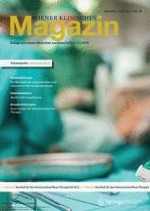Anzeige
01.11.2014 | Intensivmedizin
Die adäquate Dosierung von Antiinfektiva
Bei ANIS-Patienten mit extrakorporaler Therapie unverzichtbar
Erschienen in: Wiener klinisches Magazin | Ausgabe 5/2014
Einloggen, um Zugang zu erhaltenZusammenfassung
Hintergrund
Die Dosierung von Medikamenten bei Intensivpatienten bleibt eine Herausforderung. Während die Dosis von Katecholaminen oder Insulin nach dem biologischen Effekt, also dem mittleren arteriellen Blutdruck oder dem Blutzucker gesteuert werden kann, ist die Anpassung der Dosis von Antibiotika an die Intensität der Nierenersatztherapie deutlich schwieriger. Selbst bei Intensivpatienten mit intakter Nierenfunktion ist die Pharmakokinetik und Pharmakodynamik deutlich verändert.
Problemstellung
Aufgrund eines höheren Verteilungsvolumens („fluid rescucitation“, „capillary leak“) oder einer Hypalbuminämie kann die wirksame Konzentration eines Antibiotikums deutlich vermindert sein. Kommt ein Nierenfunktionsverlust hinzu, wird das Problem noch komplexer und die Dosierung der Antibiotika noch schwieriger, da nur bei wenigen Antibiotika die Möglichkeit des Drug Monitorings besteht. Dosierungsempfehlungen beruhen häufig, auch in der aktuellen Version, auf Verfahren mit heute nicht mehr eingesetzten Filtern und Intensitäten und sind somit häufig nicht mehr zutreffend. Dies ist durch den sog. Vancomycin-Test einfach festzustellen.
Ausblick
Langfristig wird eine Ausweitung des therapeutischen Drug Monitorings in dieser Patientenpopulation notwendig werden. Dies allein reicht aber sicher nicht aus, um patientennahe relevante Endpunkte, wie Beatmungszeit oder Tod, zu beeinflussen, sondern kann nur Ausgangspunkt für eine Qualitätsverbesserung im Bereich Infektiologie/Mikrobiologie/Pharmakotherapie sein. Um das notwendige Wissensfundament hierfür zu legen, sollte diese Problematik auch vermehrt Eingang in die Fort- und Weiterbildungspläne der entsprechenden Facharztdisziplinen aber auch in die CME Programme finden.
